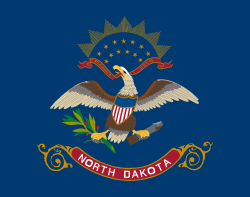#0excludeGlossary
This article's use of external links may not follow Wikipedia's policies or guidelines. (November 2024) |
North Dakota ( /dəˈkoʊtə/ ⓘ də-KOH-tə) is a U.S. state in the Upper Midwest, named after the indigenous Dakota and Sioux peoples. It is bordered by the Canadian provinces of Saskatchewan and Manitoba to the north and by the U.S. states of Minnesota to the east, South Dakota to the south, and Montana to the west. North Dakota is part of the Great Plains region, characterized by broad prairies, steppe, temperate savanna, badlands, and farmland. North Dakota is the 19th-largest state by area, but with a population of just under 800,000, the fourth-least populous and fourth-least densely populated. The state capital is Bismarck and the most populous city is Fargo, which accounts for nearly a fifth of the state's population; both cities are among the fastest-growing in the U.S., although half of North Dakotans live in rural areas.
North Dakota | |
|---|---|
| Nicknames: Peace Garden State, Roughrider State, Flickertail State, Heaven on Earth | |
| Motto(s): Liberty and Union, Now and Forever, One and Inseparable Serit ut alteri saeclo prosit "One sows for the benefit of another age" | |
| Anthem: North Dakota Hymn | |
 Location of North Dakota within the United States | |
| Country | United States |
| Before statehood | Dakota Territory |
| Admitted to the Union | November 2, 1889 (39th) |
| Capital | Bismarck |
| Largest city | Fargo |
| Largest county or equivalent | Cass |
| Largest metro and urban areas | Fargo-Moorhead |
| Government | |
| • Governor | Kelly Armstrong (R) |
| • Lieutenant Governor | Michelle Strinden (R) |
| Legislature | Legislative Assembly |
| • Upper house | Senate |
| • Lower house | House of Representatives |
| Judiciary | North Dakota Supreme Court |
| U.S. senators | John Hoeven (R) Kevin Cramer (R) |
| U.S. House delegation | Julie Fedorchak (R) (list) |
| Area | |
• Total | 70,705 sq mi (183,125 km2) |
| • Land | 68,994 sq mi (178,694 km2) |
| • Water | 1,710 sq mi (4,428 km2) 2.3% |
| • Rank | 19th |
| Dimensions | |
| • Length | 300 mi (482 km) |
| • Width | 199 mi (321 km) |
| Elevation | 1,900 ft (580 m) |
| Highest elevation | 3,507 ft (1,069 m) |
| Lowest elevation (Red River of the North at Manitoba border) | 709 ft (216 m) |
| Population (2024) | |
• Total | |
| • Rank | 47th |
| • Density | 10.7/sq mi (4.13/km2) |
| • Rank | 47th |
| • Median household income | $76,500 (2023) |
| • Income rank | 21st |
| Demonym | North Dakotan |
| Language | |
| • Official language | English |
| Time zones | |
| most of state | UTC−06:00 (Central) |
| • Summer (DST) | UTC−05:00 (CDT) |
| southwest | UTC−07:00 (Mountain) |
| • Summer (DST) | UTC−06:00 (MDT) |
| USPS abbreviation | ND |
| ISO 3166 code | US-ND |
| Traditional abbreviation | N.D., N.Dak., No.Dak |
| Latitude | 45° 56′ N to 49° 00′ N |
| Longitude | 96° 33′ W to 104° 03′ W |
| Website | nd |
What is now North Dakota was inhabited for thousands of years by various Native American tribes, including the Mandan, Hidatsa, and Arikara along the Missouri River; the Ojibwe and Cree in the northeast; and several Sioux groups (the Nakota, Dakota, and Lakota) in the rest of the state. European explorers and traders first arrived in the early 18th century, mostly in pursuit of furs.
The United States acquired the region in the early 19th century, gradually settling it amid growing resistance by increasingly displaced natives. The Dakota Territory, established in 1861, became central to American pioneers, with the Homestead Act of 1862 precipitating significant population growth and development. The traditional fur trade declined in favor of farming, particularly of wheat. The Dakota Boom of 1878 to 1886 saw giant farms stretched across the rolling prairies, with the territory becoming a regional economic power. The Northern Pacific and Great Northern railway companies competed for access to lucrative grain centers; farmers banded together in political and socioeconomic alliances that were central to the Midwest's broader Populist Movement. North and South Dakota were admitted to the Union on November 2, 1889, as the 39th and 40th states. President Benjamin Harrison shuffled the statehood papers before signing them so that no one could tell which became a state first; consequently, the two states are officially numbered in alphabetical order. Statehood marked the gradual winding-down of the pioneer period, with the state fully settled by around 1920. Subsequent decades saw a rise in radical agrarian movements and economic cooperatives, of which one legacy is the Bank of North Dakota, the nation's only state-run bank.

Beginning in the mid-20th century, North Dakota's rich natural resources became more critical to economic development; into the 21st century, oil extraction from the Bakken formation in the northwest has played a major role in the state's prosperity. Such development has led to population growth (along with high birth rates) and reduced unemployment. It is believed to contain North America's geographic center, in Rugby, and is home to what was once the tallest artificial structure in the Western Hemisphere, the KVLY-TV mast.







